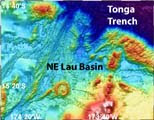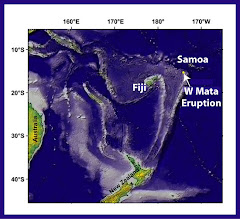Tofa Soifua and Goodbye from Samoa and the Kilo Moana
Monday May 10th, 2010. We are currently sitting outside of Apia, Western Samoa, waiting to return to shore. It is sunrise and another beautiful day in paradise. We made remarkable discoveries on this voyage and accomplished much of what we set out to do. Although the ship has been beleaguered by a host of problems and we have had to return early, it was through the hard work and dedicated effort of the crew of the R/V Kilo Moana that we were able to accomplish so much.
The NE Lau basin is an area of intense magmatic and volcanic activity. It always seems that the next hydrocast will reveal yet another volcanic eruption or site of intense hydrothermal activity. On this trip we concentrated a lot of our effort on the North Mata volcanoes. Our findings indicate that 6 of those 7 volcanoes are active. Including our previous findings of magmatic and hydrothermal activity at East and West Mata, we have found activity at 8 of the 9 Mata volcanoes. These volcanoes form a chain only 15 -16 nautical miles long making this one of the most intense areas of hydrothermal activity found on Earth. Why is this? This area of the seafloor appears to be opening and cracking, allowing more magmatic activity, making these volcanoes very different from those that we find along the mid-ocean ridge, back arc spreading centers, and even those found along the arcs.
We also found that these sites support much biological activity. This is important, because the northern-most Mata volcano represents a biogeographic terminus of hydrothermal activity for this region. In order for species to spread, there is a large geographic barrier that they must now cross to propagate to and colonize in other areas of the oceans. Each of the northern Matas is venting very methane-rich hydrothermal fluids. Methane is an important source of microbial energy and is likely one of the important energy bases for the hydrothermal food chain found at these sites (see the rocks and animals blog posting).
We look forward to our eventual return with a deep-sea robotic vehicle so that we may fully study this very exciting and incomparable place in the world’s oceans. Although we overuse the word unique, as of now we have found no other place on earth that is like the place we have found on this voyage.























